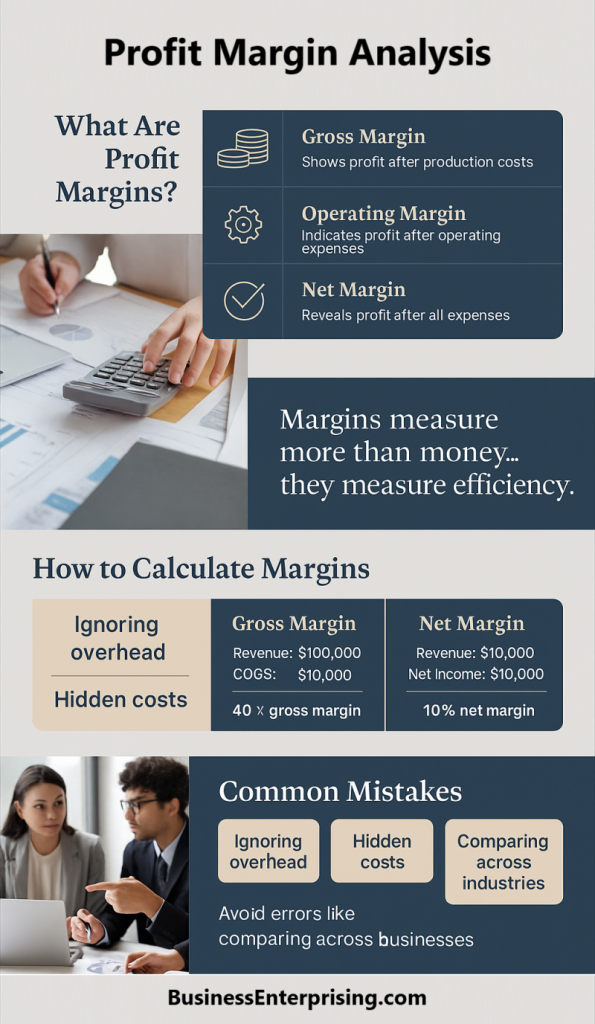
Every business has costs. Some are easy to spot, while others get buried in overhead or operations. By breaking down your margins, you can find the leaks. That means you can make informed decisions instead of reacting when profit drops. However, this only works when you look beyond surface numbers and dig into each margin level.
Additionally, margin analysis helps you fine-tune pricing, reduce waste, and identify which parts of your business carry their weight. You don’t need perfect margins, but you do need to know what’s normal for your industry. Therefore, comparing your numbers to industry averages gives your analysis more context.
Profit margins change over time. Raw materials go up. Rent increases. Demand shifts. Therefore, analyzing margins regularly lets you adapt before those changes hurt your bottom line. A strong margin doesn’t guarantee success, but a weak one often signals deeper issues.
Start with simple formulas and accurate numbers. Then ask the right questions. Over time, these habits help you run a leaner, more stable business. Knowing your margins puts you in control. Without that clarity, you are left guessing. And guessing rarely leads to profit.
Understanding Profit Margins: Gross, Operating, and Net
Understanding how profit margins work is important if you want a clear view of your business performance. There are three main types of margins to focus on. Each one gives you a different angle on how your business earns money and spends it. These are gross profit margin, operating profit margin, and net profit margin.
Your gross profit margin measures the money left after subtracting the cost of goods sold from your total revenue. It tells you how efficiently your business produces or sells its product. A higher gross margin usually means your pricing or production model is working. However, this margin does not include other expenses like payroll or rent.
Operating profit margin goes a step further. It shows what is left after covering day-to-day expenses such as labor, utilities, and office costs. This margin helps you understand the cost of running your business before taxes and interest. Additionally, it signals whether your operational strategy supports sustainable growth.
Net profit margin is what remains after all expenses, including taxes and interest, are paid. Therefore, it represents your actual bottom line. This is often the margin investors and lenders care about most. It reflects how much of your revenue turns into profit.
Each type of margin gives you useful data points. Conducting a profit margin analysis allows you to compare these numbers over time or against competitors. That way, you can spot trends, make better decisions, and improve long-term profitability.
Why Profit Margin Analysis Matters
Profit margins give you more than a number. They help you make better business decisions. By looking at your margins, you can see how well your business turns revenue into actual profit. You get a clear sense of what is working and what needs adjustment.
Conducting a profit margin analysis shows where your money goes. You can see which expenses reduce your earnings. Therefore, you gain insight into cost control. Reducing waste and tightening operations starts with knowing where you lose money. Additionally, this type of analysis helps you evaluate how each part of your business contributes to the bottom line.
Pricing becomes more strategic when you understand your margins. You know how much you must charge to cover costs and still make money. This helps you set prices that support profitability without guessing. Additionally, margin data tells you if your prices match your actual costs.
Operational decisions also become easier. If your gross margin is fine but net margin is low, your overhead may be too high. Therefore, you can review payroll, rent, or other fixed costs. Over time, tracking these shifts helps you make smarter decisions.
Investors and lenders want to see healthy margins. Profit margin analysis gives them a sense of your long-term potential. It also helps you prepare for growth. As your business grows, margin trends help you know when to invest and when to hold back. Consistent margin analysis leads to stronger performance.
How to Calculate Key Profit Margins
To calculate profit margins, you need three numbers: revenue, costs, and profit. Each margin type uses these in a different way. Your gross profit margin shows how much money you keep after covering direct costs. The formula is gross profit divided by revenue. For example, if you make $100,000 and spend $60,000 on goods, your gross margin is 40 percent.
Operating profit margin includes more of your expenses. It uses operating profit instead of gross profit. Therefore, you subtract not only product costs but also overhead like rent and payroll. If your revenue is $100,000 and your operating profit is $20,000, your margin is 20 percent. Additionally, this number reflects how efficient your daily operations are.
Net profit margin gives you the final picture. It accounts for all expenses, including interest and taxes. You calculate it by dividing net profit by revenue. For example, if your net profit is $10,000 from $100,000 in revenue, your margin is 10 percent. That means you keep ten cents of every dollar earned.
Each formula gives you a specific insight into how your business performs. Therefore, conducting a profit margin analysis helps you compare numbers across time periods. Additionally, it lets you find problem areas faster. Simple math leads to smarter decisions. Use it often and with care. Your profit margins will tell you what your numbers alone cannot.
Common Mistakes to Avoid During Analysis
When conducting a profit margin analysis, many business owners make common mistakes that weaken their results. One of the biggest errors is ignoring hidden costs. These may include transaction fees, refunds, or packaging costs. Therefore, your margins may appear stronger than they really are.
Additionally, you may overlook overhead expenses. Rent, utilities, and salaries all affect your bottom line. However, some owners only focus on direct costs. This creates an incomplete view of true profitability. Always factor in every expense that affects your operations.
Comparing your margins to unrelated businesses is another common issue. Every industry has different cost structures and pricing models. Therefore, comparing your retail margins to a software company’s can mislead you. Instead, look for benchmarks from similar business types and sizes. That way, your comparisons stay useful.
Another pitfall is relying on outdated numbers. Profit margins shift over time. Costs go up, and market conditions change. Conducting the analysis once and not updating it will limit your insight. Additionally, make sure your accounting is accurate. Incorrect entries will distort the results.
Some business owners also assume one strong margin means everything is fine. However, each type of margin tells a different story. Gross margin may look strong while net profit is weak. Therefore, you need to review all levels. Avoiding these mistakes helps you get clearer results. Better analysis leads to better decisions. Take your time, check your math, and think critically about what the numbers reveal.
Using Industry Benchmarks for Comparison
Industry benchmarks help you understand how your business compares to others like yours. These numbers show what is typical or expected. When your margins fall outside those ranges, you know something needs attention. Therefore, using benchmarks makes your analysis more useful.
Additionally, benchmarks add context to your performance. A 10 percent net profit margin may sound fine by itself. However, if your industry average is 18 percent, that gap means you are underperforming. That signals a need to adjust pricing, reduce costs, or rethink strategy.
Conducting a profit margin analysis without any point of comparison limits its value. You may feel satisfied with your numbers without realizing competitors are doing better. Therefore, industry benchmarks keep your focus realistic and grounded.
You can break down benchmarks by business type, size, or region. That helps you fine-tune comparisons for accuracy. Additionally, some industries have very tight margins while others operate with more room. For example, restaurants and grocery stores often show thinner margins than software or consulting businesses.
Once you gather this data, compare each of your margin types. See how your gross, operating, and net margins stack up. That way, you identify where you lag and where you lead. Tracking this year after year also helps you see progress.
Benchmarks are not goals. They are references. However, using them can help you make better business choices and improve how you operate. Each margin tells a story. Comparing yours to others helps you understand that story more clearly.
Improving Profit Margins Strategically
Improving profit margins takes steady action. You do not need major changes to see results. Small shifts in pricing, costs, or processes often lead to better margins. Therefore, take a close look at your current structure before making adjustments.
Start by reviewing your pricing. If your product or service offers clear value, a modest price increase may not affect demand. Additionally, review discount policies and make sure they support long-term goals. Frequent or deep discounts often cut into profits more than they help.
Cost reduction is another path. However, do not cut in ways that weaken service or product quality. Focus instead on waste, duplication, or outdated expenses. For example, renegotiate vendor contracts or reduce unused subscriptions. Additionally, keep an eye on labor costs without reducing output.
Improving your process also helps. You can often find small steps that save time or reduce materials. Streamlining operations often improves margins without needing to touch pricing. Therefore, map your workflows and look for unnecessary steps or delays.
Customer segmentation helps you focus on the most profitable groups. Not all customers bring the same value. Some buy more, refer others, or cost less to serve. Therefore, adjust your marketing and service strategies to match high-margin segments.
Conducting a profit margin analysis gives you the data to decide what needs attention. Additionally, it helps track whether your changes work. Each decision should connect back to long-term profitability. You do not need to fix everything at once. Improve one area, then move to the next. Over time, the results will show in your margins.
Conclusion
Profit margins give you more than a snapshot of revenue and expenses. They show how your business performs across several layers. Therefore, paying attention to each type of margin helps you make better decisions.
Additionally, conducting a profit margin analysis gives you clarity on what drives or limits your profit. It helps you understand where to act. Pricing, cost control, and efficiency all influence margins in different ways. However, each one starts with knowing your numbers.
Comparing your margins to industry standards helps you see where you stand. If you fall behind, you can adjust before problems grow. If you lead, you know what to protect. Therefore, use benchmarks to set reasonable expectations.
Over time, your margins may shift. Materials get more expensive. Rent may increase. Customer needs may change. Additionally, your own business model may evolve. Regular margin reviews help you stay aligned with those shifts.
Start small if you need to. Focus on one margin or one area of cost. Then measure the results before moving forward. Improving margins does not always mean cutting. Sometimes, it means focusing on what brings the most value. Profit margin analysis is not a one-time task. It should be part of your regular business review. That way, you stay ahead of problems. You also stay ready to grow. Use the data, act on the insights, and keep moving toward stronger results.


